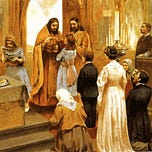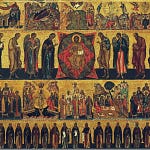[CONTINUED FROM A PREVIOUS POST]
Part 3: Prayer
Finally, the prayer rule before communion - the last-but-not-least of the three parts of preparation - is yet another oft-confusing point for many laymen. While its content is undeniably edifying, it is not at all clear whether all are obliged to recite the entire rule in every situation. Is it, for example, more important to attend the evening vigil or to recite the rule if one had to choose only one? This is not an idle question. Many young families with several small children who live far from a church do find it difficult to find time for both on a Saturday night.
The history of what we now know as the Prayers Before Communion, in the first approximation, is as follows. It is said that some pious people began saying some prayers - one or two - while waiting in line for Communion during large and lengthy celebrations - probably, sometime in the fourth and fifth centuries at cathedrals like Saint Sophia in Constantinople. Monastics, who were then developing their own forms of piety, liked the practice and adopted it for their use. Eventually, these prayers became codified and more numerous - to the point that the entire set of these pre-Communion prayers had to be moved outside of the Liturgy, as it no longer fit into the time spent waiting in line to the chalice. By now, the prayers have become so regularized that they form a mandatory part of the monastic prayer rule; and have been transformed into a para-liturgical format that is often scheduled as a separate church service in the liturgical cycle of a monastery. As is the case with many monastic rules, pious lay people have adopted the Prayers Before Communion as a part of their own preparation. But there seems to be no specific obligation for laymen to observe monastic rules or to observe them in any particular way. In other words, if a layman chooses to recite the monastic pre-Communion prayer rule - this would be very good indeed, and a pastoral recommendation to do so seems quite useful. But an expectation that all laymen must recite the entire monastic office in order to be “prepared” for Holy Communion may be as unreasonable as the idea that the rule in its present form is a kind of golden standard. Indeed, why three canons and not five, or twelve prayers and not forty? Why three canons, two akathists, and twelve prayers only once and not every day of the week? And if the reasoning is that this has been tried and adopted by the Fathers - even apart from whether any specific Fathers can be identified - it must necessarily be noted that these Fathers tried this in a monastic setting and adopted the rule for monastic use. It is not self-evident that the very same Fathers would have recommended the same monastic prayer rule, or the monastic fasting rule, or the daily schedule, or the manner of dress, for example, to married people, or even unmarried people living outside a monastery. There is a Russian saying, “don’t bring your rules into someone else's monastery” (“со своим уставом в чужой монастырь не ходят”). Perhaps, laity can be seen as their own coenobium; and it seems inappropriate to insist that the rules of the coenobium of Saint Sabbas should be applicable to the lay coenobium.
Listen to this episode with a 7-day free trial
Subscribe to Phroneo to listen to this post and get 7 days of free access to the full post archives.













